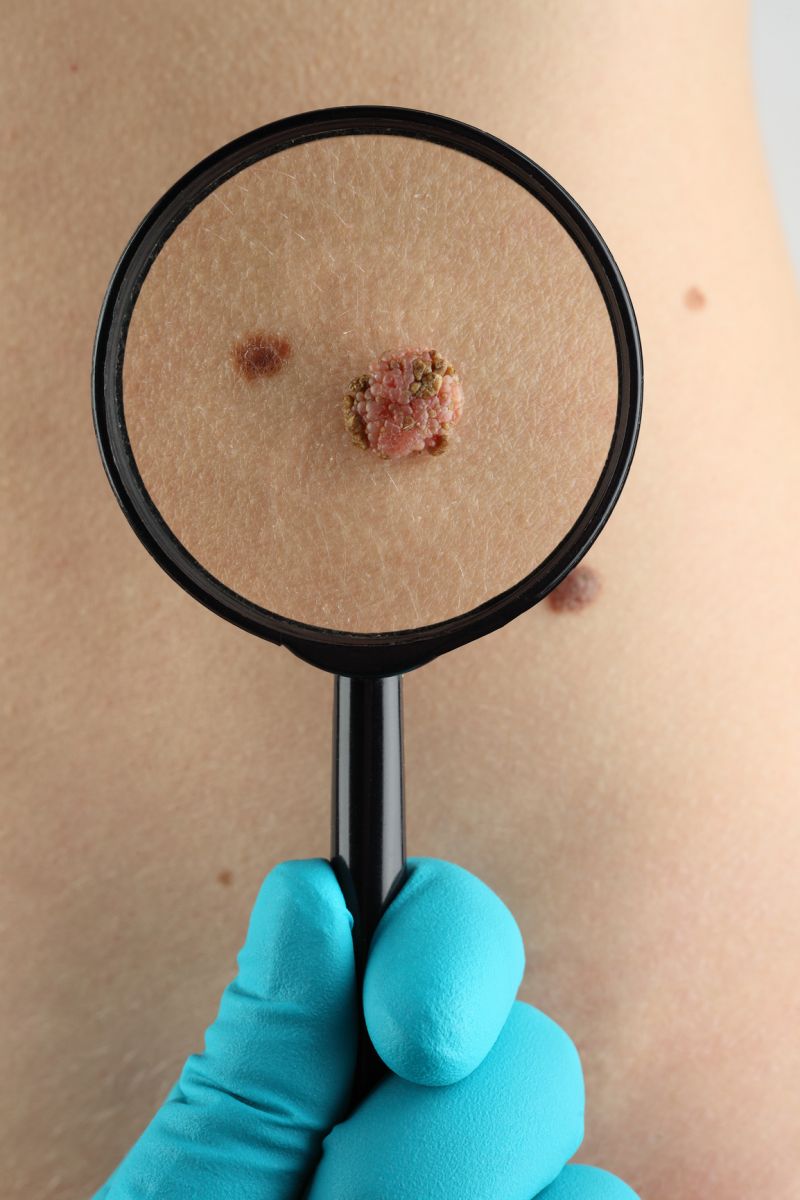Welcome to the DermacenterMD Blog
Posts for tag: health
 A good reminder from the Skin Cancer Foundation. It's important to remember that your family's medical history is crucial to your health.
A good reminder from the Skin Cancer Foundation. It's important to remember that your family's medical history is crucial to your health.
So you're sitting in the dermatologist's waiting room, filling out the usual forms required for a doctor visit. After filling in the basics, you spot the next question and realize you're stumped: it's asking about your family's medical history. Has anyone in your family had melanoma or any other form of skin cancer? Here's why the doctor asks, and what you need to know:
History Could Repeat Itself
A family history of melanoma increases your risk of developing the cancer yourself, according to Ramzi Saad, MD, a board-certified dermatologist and Skin Cancer Foundation member based in Plymouth, Massachusetts. In fact, about one in every 10 patients diagnosed with melanoma has a family member with a history of the disease. When gathering family history, Dr. Saad says, the more information, the better.
"We ask for a history of skin cancers, specifically melanoma, but getting a family history of all cancers is also important," he says. "There are some genetic connections between melanoma and other cancers."
Closer Relative, Higher Risk
Gathering accurate information about multiple family members can be a little intimidating, but Dr. Saad notes a few points that are of particular importance when digging through medical history. The number of relatives that have had melanoma, particularly first-degree relatives like parents or siblings, is a definite need-to-know. Each person with a first-degree relative diagnosed with melanoma has a whopping 50 percent greater chance of developing the disease than people who do not have a family history of the disease.
Saad says the more complete the history, the better, but the number of first-degree relatives with the disease is the most important predictive factor for an increased risk of melanoma.
Take Action
What happens if you do find out that skin cancer runs in your family? Saad recommends extra vigilance for prevention, being sure to use sunscreen every day and avoiding unnecessary sun exposure. He points to our tips on how to perform a self exam, but notes that seeing a dermatologist annually is critical as well.
“A full skin examination by a trained professional can help to identify suspicious lesions needing removal,” Dr. Saad says. A board-certified dermatologist will also be able to help patients keep an eye on lesions that may become cancerous in the future, and establish the appropriate follow-up frequency for that individual’s skin checks.
So in advance of your next skin check, try gathering some info on your family’s medical history. You might be surprised to learn that someone close to you once dealt with skin cancer, and that knowledge can help your dermatologist help you.
For more information about skin cancer see the Skin Cancer Foundations blog: http://blog.skincancer.org/2017/02/22/what-you-should-know-about-your-familys-history-of-melanoma/
If you or someone you know should have their skin checked, give us a call today at 574-522-0265 to schedule an appointment.
 Check out this article from the Skin Cancer Foundation. It's important to remember that people of all skin types and tones can be affected by skin cancer.
Check out this article from the Skin Cancer Foundation. It's important to remember that people of all skin types and tones can be affected by skin cancer.
People who have dark skin tones often believe they're not at risk for skin cancer, but that is a dangerous misconception , says dermatologist Maritza I. Perez, MD, a senior vice president of The Skin Cancer Foundation.
"Anyone can get skin cancer, regardless of race," she says. While incidence of melanoma is higher in the Caucasian population, a July 2016 study in the Journal of the American Academy of Dermatology showed it is more deadly in people of color. African American patients were most likely to be diagnosed with melanoma in its later stages than any other group in the stuy, and they also had the worst prognosis and the lowerst overall survival rate. Most skin cancers are associated with ultraviolet (UV) radiation from the sun or from tanning beds, says Dr. Perez. Yes, darker skin produces more of the pigment called melanin that does help protect skin- but onlyto a certain extent. People of color can still get sunburned, and they can also develop skin cancer from UV damage.
It’s of concern that 65 percent of African American participants in a survey said they never used sunscreen. This needs to change, says Dr. Perez. “Remember, ethnicity does not define skin type. It can represent a wide range of skin tones with a wide range of risks.” To avoid premature aging and damage that can lead to skin cancer, everyone should use sunscreen every day and practice sun-safe habits, such as seeking shade and wearing protective clothing, hats and UV-blocking sunglasses.
Additionally, certain skin cancers are caused by factors other than UV — such as genetics or environmental influences — and may occur on parts of the body rarely exposed to the sun. For example, people who have dark skin are more susceptible to acral lentiginous melanoma (ALM), an especially dangerous form of melanoma that typically appears on the palms of the hands and soles of the feet. (The Jamaican singer and musician Bob Marley died of ALM when he was only 36.)


People who have dark skin are more susceptible to acral lentiginous melanoma (ALM), like these examples above.
It’s crucial to detect skin cancer early, when it is easiest to treat and most likely to be cured. Dr. Perez says she advises people of all ethnicities to do a monthly skin self-exam and see a dermatologist annually — and sooner if any of the warning signs appear:
- A bump, patch, sore or growth that bleeds, oozes, crusts, doesn’t heal or lasts longer than a month. This may indicate basal cell carcinoma.
- An ulcer, scaly red patch, wart-like growth or sore that sometimes crusts or bleeds could be a sign of squamous cell carcinoma. This type of skin cancer can also develop in old scars or areas of previous physical trauma or inflammation.
- New or existing moles that are asymmetrical, have an irregular border, more than one color, are larger than a pencil eraser or change in any way may indicate melanoma. Pay special attention to suspicious spots on the hands, soles of the feet or under the nails, which could signify ALM.
 If you’re reading this you most likely already know what a dermatologist is and what they do. However, it can help you better understand your care and what a dermatologist can do for you. Dermatologists are medical doctors who complete a 4 year residency training in skin, hair and nail diseases. Dermatologists are also experts in skin cancer and surgery of the skin. No other area of medicine is as highly trained in the area of skin and skin cancer.
If you’re reading this you most likely already know what a dermatologist is and what they do. However, it can help you better understand your care and what a dermatologist can do for you. Dermatologists are medical doctors who complete a 4 year residency training in skin, hair and nail diseases. Dermatologists are also experts in skin cancer and surgery of the skin. No other area of medicine is as highly trained in the area of skin and skin cancer.
The training required for a dermatologist involves advanced education in greater detail than any other area of medicine in the skin, skin diseases, skin cancer diagnosis and management as well as cosmetic dermatology. Many patients seek dermatologic evaluations for routine skin cancer screening examinations as this is the highest trained specialty for this.
In addition, dermatologists are experts in other skin growths, skin cancer, rosacea, eczema, psoriasis, acne and warts so many people see dermatologist for these common skin problems. Since skin cancer is the number one cancer diagnosed in America today (affecting up to 1 in 3 people), most people go to see a dermatologist annually for a skin cancer screening examination.
Dr. Roger Moore treats patients with basal cell carcinoma and squamous cell carcinoma from Elkhart, South Bend, Goshen and all of Michiana. The renowned removal technique of Mohs Micrographic surgery is performed routinely by Dr. Moore as well. He is the first to offer this technique in Elkhart County. If you or someone you know has a skin concern or problem call Dr. Roger Moore and his team at DermacenterMD today at (574)522-0265. No referral is necessary and don’t forget, no other area of medicine is as highly trained in the skin.
 The answer is simple- YES. Check out the article below from the Skin Cancer Foundation on the importance of taking the time to check your own skin every month. It could save your life!
The answer is simple- YES. Check out the article below from the Skin Cancer Foundation on the importance of taking the time to check your own skin every month. It could save your life!
The Skin Cancer Foundation recommends that everyone practice monthly head-to-toe self examination of their skin, so that they can find any new or changing lesions that might be cancerous or precancerous. Skin cancers found and removed early are almost always curable. Learn about the warnings signs of skin cancer and what to look for during a self examination. If you spot anything suspicious, see a doctor.
Performed regularly, self examination can alert you to changes in your skin and aid in the early detection of skin cancer. It should be done often enough to become a habit, but not so often as to feel like a bother. For most people, once a month is ideal, but ask your doctor if you should do more frequent checks.
Find step-by-step instructions on how to perform a self-examination by clicking HERE.
You may find it helpful to have a doctor do a full-body exam first, to assure you that any existing spots, freckles, or moles are normal or treat any that may not be. After the first few times, self examination should take no more than 10 minutes – a small investment in what could be a life-saving procedure.
If you or someone you know has found a suspicious lesion, give our office a call to have it examined. We are accepting new patients.
DERMACENTERMD 574-522-0265
 You may be surprised by the answer to this question-
You may be surprised by the answer to this question-
If you suffer from mild to severe rosacea there are certain lifestyle changes that can be implemented to help decrease flare ups and keep symptoms to a minimum. These aggravating factors may or may not affect your flare ups, but if you find that they do, it may be a good idea to avoid or reduce these activities in the future.
- Sun exposure-
It is important to protect your skin from the sun using daily sunscreen and wearing a hat to shield your skin. Even a small amount of sun exposure can cause rosacea to flare.
- Hot liquids-
Many people with rosacea report having flare ups when they ingest hot liquids such as coffee or teas. Try your coffee or tea iced for a period of time and see if your symptoms improve or subside.
- Spicy Foods-
Avoiding spicy foods may also improve symptoms of rosacea. Often times, the spike in body temperature induced by spicy foods is thought to cause flare ups.
- Emotional Upset-
Feelings of stress, anger or embarrassment are thought to make rosacea symptoms worse.
- Seasonal Changes-
Changes in the weather can also affect flare ups. According to a new National Rosacea Society (NRS) patient survey, nearly 90% of 852 survey respondents said their rosacea is affected by the change in seasons.
- Alcohol-
Having a glass of wine at the end of a stressful day sounds relaxing, but if you suffer from rosacea it may cause flushing to become worse. The reason for this is unknown, however, alcohol does not cause rosacea despite pervious popular belief.
- Temperature Extremes-
Extreme hot and cold can cause flare ups of rosacea to be more frequent. If you must be exposed to extreme temperatures, try to stay covered up or stay cool to keep your body temperature as regular as possible.
- Strenuous exercise-
Exercise has been reported to increase flare ups and cause flushing. Taking it easy can be beneficial to thwart symptoms.
- Hot baths or saunas-
Once again, avoiding extremes in temperatures such as hot showers or baths can help reduce flushing. Maintaining a regular body temperature can help reduce flare ups.
- Drugs that dilate blood vessels, including some blood pressure medications-
Rosacea affects the blood vessels of the face and any drug that dilates blood vessels can increase irritation and flushing.
Making simple lifestyle changes like avoiding certain aggravating factors, such as the ones listed above, can help to reduce your symptoms and flare ups. However, going in to see your doctor can be the best choice. Your dermatologist can evaluate your skin can determine the best course of action for treatment. Many prescription topicals can provide significant improvement.
Source: via http://www.webmd.com/skin-problems-and-treatments/news/20040218/link-between-rosacea-alcohol
Archive:
Tags
- dry skin (2)
- moisturizer (1)
- sensitive skin (3)
- PA (2)
- Skincare (2)
- skin cancer (29)
- cancer (6)
- facts (1)
- skin (19)
- dermatology (22)
- skin care (19)
- cosmetic (2)
- wrinkles (1)
- Botox (4)
- Dysport (3)
- sleep (1)
- look good (1)
- daily routine (1)
- healthy lifestyle (1)
- doctor (2)
- patient (1)
- sun protection (5)
- sunscreen (14)
- aging dermatology (1)
- providers (1)
- tanning (2)
- sun (6)
- UVA rays (2)
- UVB rays (2)
- melanoma (10)
- Acne (2)
- Treatment (2)
- sunscren (1)
- sun exposure (5)
- Melanoma Monday (2)
- Skin Cancer Awareness Month (1)
- education (2)
- skin cancer specialist (1)
- basal cell carcinoma (1)
- squamous cell carcinoma (1)
- ingredients (2)
- improve your smile (1)
- cosmetics (1)
- laser (1)
- fillers (2)
- sunburn (3)
- avoid the sun (1)
- hat (1)
- sun clothing (1)
- SPF (1)
- Rosacea (3)
- NP (1)
- Nurse Practitioner (1)
- mid-level provider (1)
- physician (1)
- dermatologist (6)
- cosmetic dermatology (4)
- anti-aging (2)
- youthful looks (1)
- Eczema (2)
- rash (2)
- itch (1)
- the rash that itches (1)
- reduce itch (1)
- itching (1)
- getting along with others (1)
- basal cell (2)
- squamous cell (2)
- detection (1)
- Mohs surgery (2)
- photoaging (1)
- Inspiring (1)
- word of the day (1)
- inspiration (3)
- uplifting (1)
- protection (4)
- lips (1)
- reduce wrinkles (1)
- look younger (1)
- encouragement (1)
- never give up (1)
- you can do it (1)
- medical school (1)
- dreams (1)
- brown spots (1)
- moles (2)
- liver spots (1)
- age spots (1)
- Abe Lincoln (1)
- life lessons (1)
- lip cancer (1)
- health (12)
- motivation (1)
- work (1)
- people (2)
- home life (1)
- lifestyle (1)
- ABCDEs of Melanoma (1)
- mole (1)
- skin check (2)
- skin facts (2)
- odd (1)
- fun (1)
- interesting (1)
- lung cancer (1)
- disease (1)
- Christmas (2)
- gifts (1)
- sun burn (1)
- winter skin tips (1)
- itchy skin (1)
- winter skin (1)
- myths (1)
- myth busted (1)
- skin protection (1)
- sunscreen safety (1)
- specialist (1)
- red skin (1)
- irritation (1)
- feel good (1)
- helping (1)
- help (1)
- helping others (1)
- treatment options (1)
- skin health (9)
- Vitamin D (2)
- tanning beds (1)
- skin health. dermatology (1)
- sunshine (1)
- awareness (1)
- prevention (1)
- sun damage (3)
- connections (1)
- working together (1)
- health care (1)
- biotin (1)
- medical (1)
- aging (1)
- elkhart (1)
- Roger Moore (1)
- check (1)
- skin type (1)
- skin cancer prevention (1)
- gift guide (1)
- Christmas gift guide (1)
- Dr. Roger Moore (1)
- holidays (1)
- family history (1)
